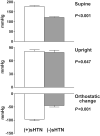Renal impairment of pure autonomic failure
- PMID: 19738158
- PMCID: PMC2796115
- DOI: 10.1161/HYPERTENSIONAHA.109.136853
Renal impairment of pure autonomic failure
Abstract
Supine hypertension is difficult to manage in patients with pure autonomic failure (PAF), because treatment can worsen orthostatic hypotension. Supine hypertension in PAF has been associated with left ventricular hypertrophy, but end organ damage in the kidney has not been assessed. We reviewed hemodynamic and laboratory data of 64 male patients with PAF who were 69+/-11 (mean+/-SD) years old. Systolic blood pressure fell by 67+/-40 mm Hg within 10 minutes of standing, with an inappropriately low 13+/-11-bpm increase in heart rate. Plasma norepinephrine levels were below normal (0.62+/-0.32 nmol/L supine and 1.28+/-1.25 nmol/L standing). A control data set of 75 men (67+/-12 years) was obtained from a deidentified version of the Vanderbilt University Medical Center electronic medical chart database. Compared with controls, PAF patients had lower hemoglobin (8.3+/-0.9 versus 9.3+/-0.8 mmol/L; P<0.001), packed cell volume (0.40+/-0.04 versus 0.45+/-0.04; P<0.001), and red blood cell count (4.4+/-0.5 x 10(12) versus 5.0+/-0.5 x 10(12) cells/L; P<0.001). Serum creatinine and blood urea nitrogen levels were elevated in patients. Forty-eight percent of patients with PAF had supine hypertension (supine systolic blood pressure: > or = 150 mm Hg). Serum creatinine was higher in patients with supine hypertension (133+/-44 versus 106+/-27 micromol/L; P=0.021) and estimated glomerular filtration rate was lower (57+/-22 versus 70+/-20 mL/min per 1.73 m2; P=0.022) compared with patients who did not have supine hypertension. These findings may indicate that renal function is diminished in PAF in association with supine hypertension.
Conflict of interest statement
Figures



References
-
- Kaufmann H. Consensus statement on the definition of orthostatic hypotension, pure autonomic failure and multiple system atrophy. Clin Auton Res. 1996;6:125–126. - PubMed
-
- Vagaonescu TD, Saadia D, Tuhrim S, Phillips RA, Kaufmann H. Hypertensive cardiovascular damage in patients with primary autonomic failure. Lancet. 2000;355:725–726. - PubMed
-
- Elkayam L, Matalon A, Tseng CH, Axelrod F. Prevalence and severity of renal disease in familial dysautonomia. Am J Kidney Dis. 2006;48:780–786. - PubMed
-
- Garland E, Raj SR, Biaggioni I, Black BK, Robertson D. A hyperdopaminergic nephropathy in DBH deficiency. Clin Auton Res. 2005;15:321.
-
- Man in 't Veld AJ, Boomsma F, Moleman P, Schalekamp MA. Congenital dopamine-β-hydroxylase deficiency: A novel orthostatic syndrome. Lancet. 1987;1:183–187. - PubMed
Publication types
MeSH terms
Substances
Grants and funding
LinkOut - more resources
Full Text Sources
Medical

